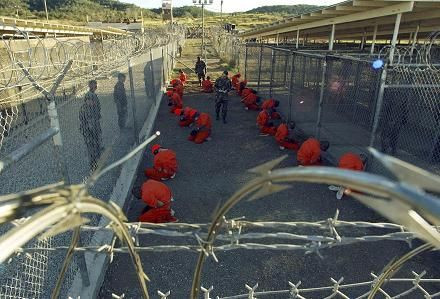Guantanamo Could Be Closed, Report Suggests

Conventional U.S. detention facilities would likely be capable of housing Guantanamo Bay’s detainee population, according to a new government report.
The Government Accountability Office (GAO) analysis does not make specific policy recommendations and notes that there would be legal and logistical obstacles to transferring inmates from the prison at Guantanamo Bay, Cuba, to facilities in the continental United States. But the report’s authors conclude that domestic prisons run under the auspices of the U.S. Department of Justice could likely absorb the 166 people held at Guantanamo Bay as of November 2012.
A network of prisons overseen by the Bureau of Prisons and the Marshals Service already houses some 377 inmates (as of August) who were charged with or convicted of terrorism-related crimes, the report found. And while the Department of Justice said it has not made any preparations to accept transfers from Guantanamo Bay, officials said the system is probably adequate to do so.
“BOP and the Marshals Service have the correctional expertise to safely and securely house detainees with a history of or nexus to terrorism,” the report found.
President Barack Obama campaigned in 2008 on a promise to close Guantanamo Bay, which had become a symbol of U.S. military excesses and civil liberties violations in the post-Sept. 11 era. One of Obama’s first acts as president was to sign an executive order calling for the notorious facility to be closed, and he issued a memorandum directing the Department of Justice to acquire a state prison in Thompson, Ill., to replace Guantanamo.
But the president met heavy resistance to the idea of holding Guantanamo Bay detainees in the United States. Congress passed a series of measures that effectively prohibited the government from moving Guantanamo detainees to the U.S. for trial. In March of 2011, President Obama signed an executive order formally creating a framework for indefinite detention at Guantanamo and announcing the resumption of military commissions.
The GAO report does not wade into thorny legal issues such as detainees’ rights to habeas corpus or an attorney. But it found that correctional facilities already in operation could theoretically take on Guantanamo Bay’s current population.
There would be some impediments. The Department of Justice does not currently have the legal authority to take custody of terror suspects who have been convicted in military trials or detained under the Authorization for the Use of Military Force, a law that gives the president broad powers to kill and imprison people with ties to the perpetrators of the Sept. 11, 2001 attacks.
Other issues could include making cultural and religious accommodations, ensuring that higher-risk suspects would be segregated from other detainees and shoring up a lack of adequate intelligence-gathering facilities. There are also legal barriers like a law barring U.S. military members being held at American facilities from “immediate association” with foreign nationals.
Sen. Dianne Feinstein, D-Calif., who commissioned the report, touted its findings as a sign that the United States could turn the page on Guantanamo.
“This report demonstrates that if the political will exists, we could finally close Guantanamo without imperiling our national security,” Feinstein, who chairs the Senate Intelligence Committee, said in a press release. “The GAO report makes clear that numerous prisons exist inside the United States -- operated by both the Department of Defense and the Department of Justice -- capable of holding the 166 detainees who remain at Guantanamo in an environment that meets the security requirements.”
© Copyright IBTimes 2024. All rights reserved.





















